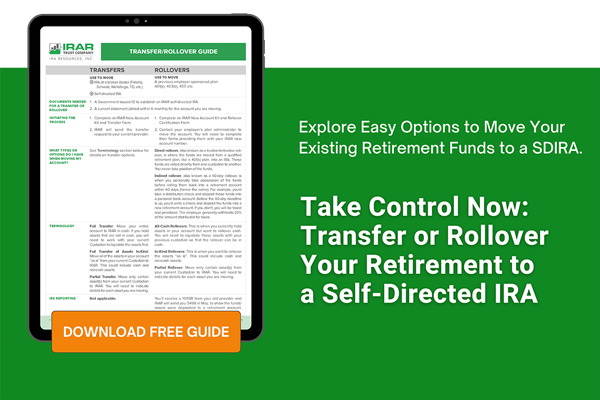IRA Transfers: A Detailed Roadmap with IRAR

A self-directed IRA is a useful tool for individuals to save for retirement, offering tax advantages and diversifying their investment portfolio with alternative assets. If you are considering transferring your current IRA to another custodian, such as IRAR, this article will provide you with insight into the transfer process to help you navigate the transfer process, along with comprehensive steps to do so.
Follow these steps to ensure the correct and speedy funding of your IRAR account.
How does an IRA Transfer work?
Transferring your funds from custodian to custodian is the quickest way to fund your self-directed IRA account at IRAR. In this process, IRAR initiates a request for the funds on your behalf, by sending a form to your old custodian a form that you will have completed and signed.
The old custodian will review the request, and if everything is good, they will directly transfer the funds/assets to your new IRAR account! Sounds like a clean transaction, right? That’s because it is.
What is an IRA Transfer?
An IRA transfer means moving your existing IRA to another IRA at a different institution. This process involves the movement of funds or assets between custodians. A transfer is not only the quickest method but also the most efficient way to fund your IRA.
If you are transferring IRA assets that are not cash (private placement, real estate, etc.), this is called an in-kind transfer.
How to Transfer Money from Your Current Custodian to IRAR:
- Open an IRAR Account: Start by completing the online new account form.
- Complete Transfer Form: Fill out a transfer form provided by IRAR and submit it for processing.
- Review and Authorization: IRAR will review the form to ensure accuracy. Once reviewed, the paperwork will be sent to your current custodian.
- Follow up with Your Current Custodian: Once IRAR sends the transfer request, it is in your current custodian’s hands and now on their timeline. IRAR cannot directly communicate with your current custodian regarding the transfer. If you wish to expedite the process, contact your current custodian, and inquire about updates on the transmittal of funds or assets.
Once your account is opened and you are completing the transfer form, there are a few important questions to remember regarding this process. Let's dive into the frequently asked questions.
What is Not Transferable?
We welcome most alternative assets, but certain assets cannot be directly transferred such as mutual funds or precious metals. Before initiating the transfer process, ensure that your mutual funds or precious metals are liquidated. Additionally, worthless assets cannot be transferred; it's essential to update their value with your current custodian before initiating the transfer.
Do I Need a Medallion Stamp?
Each custodian bears different rules on medallion stamps. It is best practice to contact and ask your current custodian to inquire if a Medallion Signature Guarantee is required to transfer your assets to avoid any hiccups. If you need a medallion stamp, just give us a heads-up on the transfer form and IRAR will be more than happy to provide this service for you.
How Long Until the Funds are Transferred to IRAR?
The timeline for the transfer can be impacted by a few things. If you require an expedited transfer, communicate directly with your current custodian, as IRAR has no control over their processing timeline. IRAR will not be given information about your account on your behalf.
How Do I Know if the Transfer is Complete?
IRAR will send you a confirmation email detailing that the funds/assets have been received or further instructions if additional information is needed.
Is There Additional Documentation Required by IRAR?
For specific asset types such as real estate, LLCs, or private stocks, additional documentation may be required to show the change of custodians. IRAR's team will send you instructions as well as assist you in collecting and submitting the necessary paperwork.
Are There Any Fees?
The process of initiating a transfer request with IRAR incurs no fees. However, a $30 fee is applicable if the transfer is conducted via wire. Additionally, there is a $30 fee for overnight delivery if your custodian requires the original transfer forms, although most custodians offer fax options, eliminating the need for overnight delivery in many cases.
How Many Transfers Can You Make a Year?
Unlike rollovers, which are subject to limitations, transfers are not reported to the IRS and allow for an unlimited number of transactions each year. This flexibility provides individuals with greater control over their IRA assets.
Conclusion
Understanding the intricacies of the IRA transfer process is crucial for a seamless transition to a new custodian. As you consider the many opportunities within self-directed IRAs, remember that a well-executed transfer can pave the way for a more diversified and robust retirement portfolio. If you need help with your transfer, give us a call. We are here to help, 888-322-6534.









Comments (2)